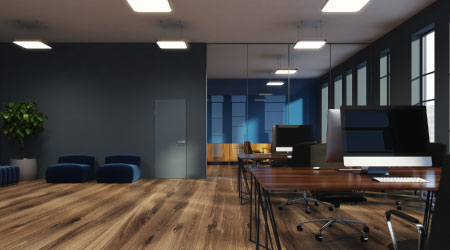Hard Floorcovering Materials Include Stone, Ceramic and Wood
If you need a hard floorcovering in part or all of your facility, stone, ceramic, and wood are all options.
Natural stone refers to slate, marble, limestone, travertine, granite, and sandstone.
Impervious materials resist absorption of liquids and thus will be easier to maintain. They are often used in high traffic commercial applications. Granite and marble are the least absorbent.
Terrazzo can fit into this category in that it is made up of marble, quartz, granite, and glass held together with a cementitious or chemical binder.
Ceramic floorcoverings are clay-based and include ceramic, porcelain, and quarry tiles. Porcelain tiles are fired at much higher temperature than ordinary ceramic tiles and thus are a high performance product.
Ceramic floorcoverings rated Class 4 and 5 — moderate to heavier and heavy to extra heavy traffic ratings, respectively —should be used in a commercial application.
There are two ways to install ceramic tile. Thin set means that a thin layer of mortar bonds the tile to a substrate. Thick set or mud set, not surprisingly, indicates a thick layer of mortar. Thick set is effective for large sized tile but is more labor intensive and challenging.
Wood Floorcoverings
There are a multitude of wood floorcovering choices and species. Facility managers should remember that wood is still a tree in a different form, so it can dent, scratch, expand, contract, crack, cup, distort, etc. You can take the wood out of the forest but you can't take the forest out of the wood. Picking the right product is key to performance.
Hardwood is 100 percent hardwood milled from lumber which can be refinished repeatedly.
Engineered wood is layers of wood glued together with a veneer (wear layer) glued to the top. The layers run in opposite directions to keep the board more dimensionally stable than hardwood. Engineered wood can be refinished, depending on the wear layer, a limited number of times.
Hardness is rated on the Janka Scale.
Finish refers to a topcoat of a finishing material, such as polyurethane, which adds performance and appearance to the wood. Wood can be pre-finished or site-finished. Pre-finished wood gets a top coat at the factory that is "baked" on; it can be installed as-is. Site-finished wood is sanded and finished at the installation site. That's a slower process, since you have to wait for the finish to dry and it may require several coats. Site-finished may be the only way to get a special color or patina.
Finding the correct floorcovering for a specific application will optimize performance, protect your investment, and minimize your maintenance costs. This can be a challenging task but it certainly can be done.
Lewis Migliore is president of LGM and Associates, which offers technical flooring services. Contact him at lgmtcs@optilink.us.
Related Topics:














